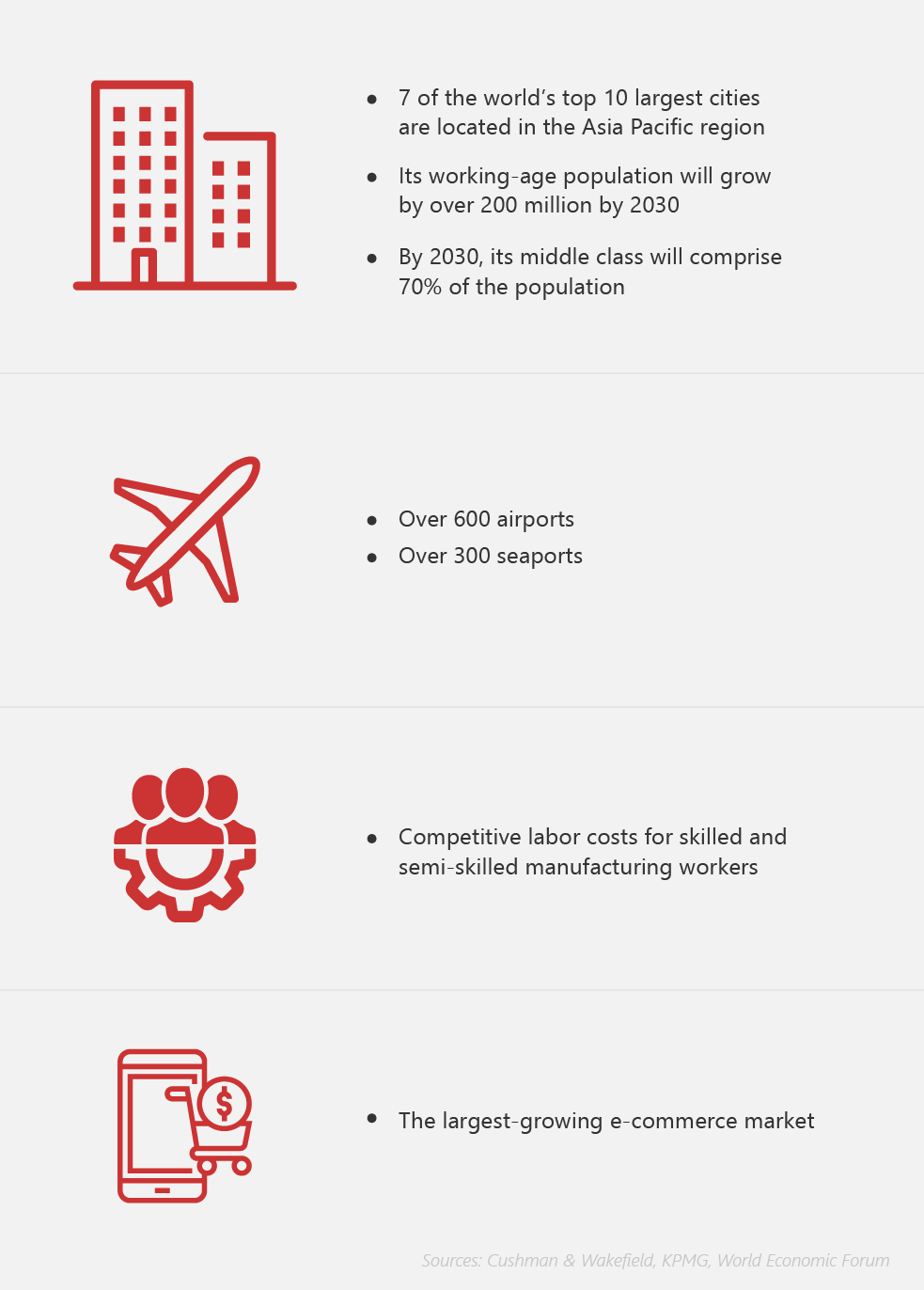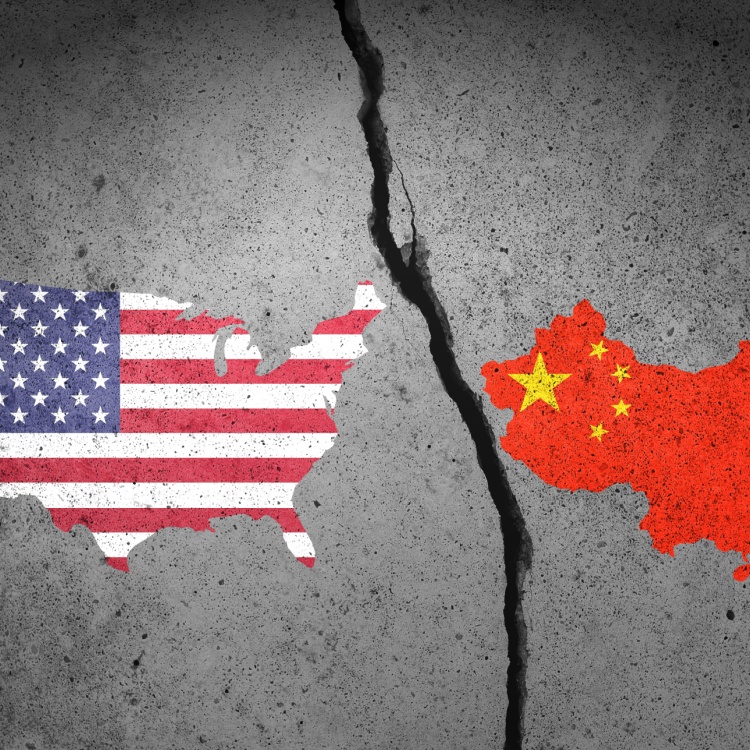How Asia Can Future-Proof Global Supply Chains

Discover why companies should turn their eye to Asia to develop a strong, resilient, and diversified supply chain.
As country borders in Southeast Asia begin to reopen, we explore how establishing manufacturing operations in the region can help companies withstand shocks or disruptions in their global supply chains. Which industries can gain a competitive advantage by expanding their operations in Asia?
Eye on Asia
Home to 55% of the global population and responsible for 36% of the world’s economy, Asia is poised to be an attractive alternative for companies hoping to strengthen and diversify their supply chains.

Opportunities for boosting existing supply chains and pioneering new sectors
With a growing urban and working-age population, competitive labor costs, a booming e-commerce market, and infrastructure for seamless trade and transport connectivity, the region presents opportunities for businesses to expand and diversify their manufacturing.
Global professional services organization Ernst & Young predicts that these four sectors will see substantial growth after the pandemic: consumer goods, healthcare equipment, electronic manufacturing services (EMS), and agritech.
Consumer goods
Comprised of apparel, personal care, and home care, this sector is benefiting from changes in consumer purchase patterns, government support, and the emergence of super apps in Southeast Asia.
(Also read: What the World Can Learn from Chinese Apps)
Healthcare equipment
The region is seeing strong growth in telehealth, remote patient monitoring, diagnostics, and digital therapeutics. Specifically, Singapore is one of the fastest-growing hubs of this sector, bolstered by strong intellectual property laws, a broad research network, and a sound business environment.
(Also read: Smart Aging: Tech for Senior Citizens)
Electronic manufacturing services (EMS)
Companies looking to develop more resilient supply chain networks are eyeing the region, opening up opportunities in the EMS sector for Southeast Asia. Six of the world’s top ten EMS companies are operating in Singapore. Intel announced last December that it is investing USD 7.1 billion to expand its semiconductor manufacturing operations in Malaysia.
Agritech
Last 2020, Southeast Asia received around USD 700 million of agri foodtech investments, reflecting the growing importance of sustainability and healthy food options.
(Also read: Agrivoltaics: Boosting Clean Energy and Food Security)
In its June 2021 publication, the Boston Consulting Group (BCG) identified the industrial sectors that ASEAN manufacturers could break into because of supply chain shifts.
Medical technology and biopharmaceutical products
Southeast Asia relies heavily on imported products for this sector, highlighting the need for strong regional supply chains to minimize shortages and supply disruptions. According to BCG, this market is growing by 8% annually and could reach USD 53 billion in the region by 2024.
Next-generation automotive and mobility
Excluding China, Japan, and South Korea, the Asia-Pacific EV market is projected to reach USD 64 billion by 2024. Major OEMs such as General Motors, Ford, BMW, and Nissan, which already have large-scale manufacturing operations in the region, are making EVs a top priority. Car manufacturers hoping to gain a secure foothold in the region’s EV market are investing heavily in Southeast Asia. Last March, South Korean carmaker Hyundai inaugurated its first EV assembly plant in Indonesia, a country rich in raw materials used in EV batteries. Meanwhile, Chinese automaker Great Wall Motor opened a smart factory in Thailand, the company’s first in Southeast Asia.
Factors that are shaping a shift in supply chains
From sourcing and logistics to procurement and production, supply chain processes have been severely disrupted by the COVID-19 pandemic, trade wars, geopolitical tensions, and climate change.
The rise of nationalist sentiment and the U.S.-China rivalry has politicized trade, pushing companies to consider alternative production sites and re-evaluate their supply chain network. Some businesses are adopting a China Plus One strategy, maintaining robust manufacturing operations in China while also looking into additional manufacturing sites.
On the plus side, free trade agreements are accelerating the flow of finished goods and capital within Southeast Asia. In 2020, the Regional Comprehensive Economic Partnership (RCEP) agreement was signed by Australia, China, Japan, New Zealand, South Korea, and all ASEAN members. The free trade agreement will strengthen the region’s position as a manufacturing base and provide greater access to Asia’s market.
In the booming e-commerce market, consumers are demanding greater convenience, faster transactions, and a personalized customer experience. An agile and efficient digital supply chain that leverages predictive analytics for end-to-end visibility will enable businesses to quickly respond to changes in consumer behavior.
The rise of Asia
Asia boasts a growing and dynamic domestic market, a young and skilled talent pool, and low-cost manufacturing hubs. As companies seek to recover from the pandemic, the stage is set for expanding operations in Southeast Asia, enabling them to develop an agile, resilient, and risk-aware supply chain for the future.
As one of the Top 19 EMS companies in the world, IMI has over 40 years of experience in providing electronics manufacturing and technology solutions.
We are ready to support your business on a global scale.
Our proven technical expertise, worldwide reach, and vast experience in high-growth and emerging markets make us the ideal global manufacturing solutions partner.
Let's work together to build our future today.



